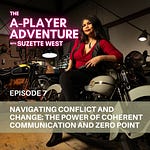Leadership is no longer about simply giving direction or driving results. In today’s high-pressure, constantly shifting environment, leadership has become a full-spectrum endeavor that demands internal mastery, emotional regulation, and the ability to guide teams through complexity with clarity and grace. At the heart of this expanded leadership paradigm lies one essential skill set: cultivating and sustaining heart coherence.
In my latest video presentation, Practical Strategies for Heart-Coherent Leadership Teams, I walk through an empowered science-backed leadership approach to managing stress, building trust, and leading effectively under pressure. Heart coherence is more than just a wellness buzzword; it is a measurable physiological state that synchronizes the nervous system, stabilizes emotions, and clears the mental clutter that often derails high-stakes conversations and decisions. It helps leaders stay steady and clear-headed when challenges arise, instead of getting caught up in stress, reacting impulsively, and making critical decisions hastily.
Why does this matter so much right now? Because the stakes have never been higher. Organizations today are contending with unprecedented levels of stress, burnout, and fragmentation. The emotional states of leaders ripple outward, influencing morale, culture, and productivity far more than most realize. A single emotionally incoherent leader—rushed, anxious, or combative—can inadvertently destabilize an entire team. But the inverse is also true: a leader who is grounded, coherent, and attuned becomes a stabilizing force, a lighthouse guiding others through turbulent times.
Heart coherence is crucial in resolving conflict because it helps leaders stay grounded and self-aware enough to hold space for differing perspectives, navigate complexity, and discern missing context that prevents opposing views from reaching mutual understanding. Most unresolved conflicts occur because people are not on the same page. Getting stakeholders aligned is essential to begin bridging that gap. Coherent communication is key to this process. It is about maintaining inner balance to support the clarity needed to communicate from a calm, centered place anchored in truth.
Heart-coherent people are less likely to be hijacked by fear, frustration, or defensiveness. Instead, we can hold space for differences, listen deeply, and speak clearly and respectfully to arrive at a meaningful resolution of a conflict or crisis. Coherence forms the physiological basis for courageous dialogue that transforms tension into trust. Coherence makes coherent communication possible (HeartMath, 2022). From a physiological standpoint, a heart-coherent state helps leaders maintain access to the prefrontal cortex that gets cut off when triggered by a stress response.
The prefrontal cortex is the part of the brain responsible for executive thinking, decision-making, and empathy (Arnsten, 2009). Without being heart-coherent, we are more likely to react from an “amygdala hijack” (Goleman, 2020), where fear, stress, and ego override rational thought, leading to impulsive and often destructive decisions. Leading with heart-intelligence allows us to access the full capacity of the prefrontal cortex so that we can respond with wisdom, empathy, and discernment—even under pressure.
The presentation also includes a simple yet powerful technique developed by the HeartMath Institute to help leaders access this state of coherence: the Heart-Focused Breathing technique. This accessible practice, which can be done in under a minute, quickly calms the nervous system and harmonizes the mind and body. Whether practiced alone or as a team before meetings, this technique helps create the conditions for clear thinking, compassionate leadership, and courageous decision-making.
The implications are profound. When coherent communication becomes the norm, trust deepens. Collaboration becomes less forced and more natural. Team members feel seen, heard, and empowered. Heart coherence allows for resolution without reactivity even in moments of disagreement or tension. This is how organizational cultures transform—from within, one coherent leader at a time.
Leadership coherence is essential work that applies to all levels of life. It is a precious resource that requires intentional cultivation. The future of leadership (among other things) depends on it.
References
Arnsten, A. F. T. (2009). Stress signalling pathways that impair prefrontal cortex structure and function. Nature Reviews Neuroscience, 10(6), 410–422. https://doi.org/10.1038/nrn2648
Goleman, D. (2020). Emotional Intelligence: 25th Anniversary Edition. Bantam. https://www.penguinrandomhouse.com/books/69105/emotional-intelligence-by-daniel-goleman/
HeartMath. (2022, September 13). What is Heart Coherence? HeartMath. Retrieved May 12, 2025, from https://www.heartmath.com/blog/health-and-wellness/what-is-heart-coherence












Share this post